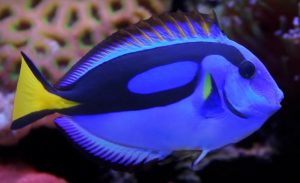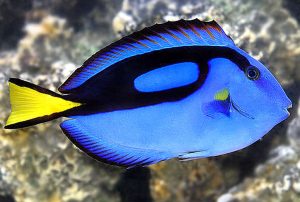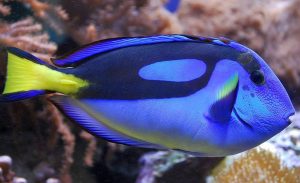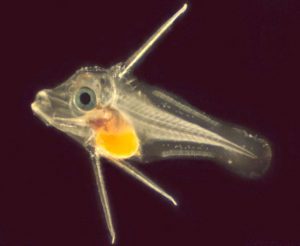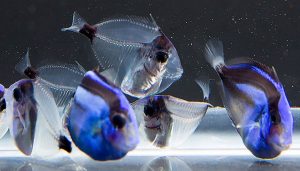Blue Tang (Paracanthurus hepatus) known to tropical fish keeping enthusiasts as the Regal Tang, Palette Surgeonfish, Pacific Blue Tang, Royal Blue Tang, Hippo Tang, Blue Hippo Tang, Flagtail Surgeonfish, Pacific Regal Blue Tang, Hepatus Tang, and Blue Surgeonsfish is native to tropical reefs across the Indo Pacific and is the only member of the genus Paracanthurus.
The Blue Tang has been encountered in the Great Barrier Reef of Australia, East Africa, (including the Mascarene Islands to Kiribati) Indonesia, Japan, New Caledonia, the Philippines, Samoa, Sri Lanka as well as the Mediterranean Sea off Israel.
Blue Tangs are usually seen in pairs and small pods of 8 to 14 individuals among cauliflower corals (Pocillopora eydouxi) that grow along the clear, current swept terraces on the seaward sides of the coral reefs of their range, at depths from 6 to over 130 feet, where they congregate in loose aggregations 3 to 6 feet off the bottom. Juveniles and adults are typically encountered hovering over isolated Pocillopora Eydoxi coral heads where they hide themselves tightly among the branches when startled.
Blue Tangs are a benthopelagic species that feed primarily on zooplankton and occasionally algae among the coral heads. Because they eat the algae overgrowth that may otherwise choke cauliflower corals, Paracanthurus hepatus is very necessary to their health on the reef.
The Blue Tang has a flat, pancake like appearance; with a circular body shape, a pointed snout like nose, and tiny scales. It has a vibrant royal blue body color with a black “palette” design that begins above the eye and progresses under the dorsal fin and above the lateral line to the yellow caudal fin. The dorsal and anal fins are blue edged in black. The bright yellow tail is also edged in black. Males are generally larger than females.
Individuals collected in the west central Indian Ocean have a yellow lower body.
The Blue Tang is an active species that is best housed in a mature FOWLR or reef aquarium of at least 180 gallon capacity with a crushed coral or reef sand substrate, large amounts of mature live rock arranged into caves, crevices, and ledges for them to graze on and hide among, and plenty of free swimming space. Paracanthurus hepatus are reef safe and will ignore corals, decorative clams, and invertebrates in a reef tank.
In a FOWLR tank they are generally peaceful towards most tankmates, but they can become aggressive towards other fish of its own species when housed in a smaller aquarium. It is possible to keep pairs and multiple specimens in larger marine systems by introducing the entire group at one time. The Blue Tang requires highly oxygenated, pristine water quality for them to thrive in an aquarium environment; so a quality reef filtration system, skimmer, powerheads
, and regular water changes are necessary
In 2016 after a six year long effort by biologist Kevin Barden of Rising Tide Conservation, the Palette Surgeonfish has finally been successfully bred in captivity.
Spawning occurs during the late afternoon and evening hours and is indicated by a change in the fish’s body color from the uniform dark blue, to a pale blue.
Paracanthurus hepatus are group spawners. Males will aggressively court the females in the school until they are ready to spawn. The pairs will quickly rush toward the surface in the water column where the eggs and sperm are released. Each of the small (1⁄32 in dia.), pelagic, eggs contain a single droplet of oil for flotation. The fertilized eggs hatch out in about twenty four hours.
The small, translucent larvae have silvery abdomens and rudimentary caudal spines and remain in the planktonic stage for up to 60 days. When they are close to 1 inch in size, the small larvae settle out of the water column to the bottom where they feed on small zooplankton among the seagrass until they develop into juveniles. The black “palette” pattern on juveniles do not fully connect until they fully mature. Paracanthurus hepatus reach sexual maturity in approximately 9 to 12 months.
In their natural environment, Juvenile Blue Tangs feed primarily on plankton. Adults are omnivores that feed on plankton and algae among Pocillopora Eydoxi coral heads. In an aquarium environment with large quantities of aged live rock for grazing, they remain picky eaters that require a varied diet of meaty items and marine algae.
Although most Tangs require a steady diet of algae, the Pacific Blue Tang should also be fed meaty fares to satisfy its zooplankton dietary requirements. Finely chopped fresh or frozen shrimp, Mysis shrimp, brine shrimp, and flake foods soaked in a liquid vitamin supplement like Kent Marine Zoecon
, Selcon, or garlic
to ward off parasites is highly recommended.
Dried seaweed offered on a veggie clip or some Nori tied to a rock should also be feed at least 3 times per week. Sea Veggies, Seaweed Salad, and Ocean Nutrition are all good, easy to use products that will keep them healthy.
It is important that they are provided plenty of marine based seaweed and algae along with meaty fares to strengthen their immune system, reduce aggression, and improve their overall health.
Because tangs produce much less body slime than other saltwater fish, they are often referred to as “dry skinned” fish. The lack of body slime makes them very susceptible to Cryptocaryon (saltwater ich), lateral line disease, fin erosion, hole in the head, and other marine diseases. Pristine water quality and a varied diet will keep your Blue Tang in optimal health.
The Blue Tang (Paracanthurus hepatus) is readily available to tropical fish keeping enthusiasts at reasonable prices from specialty fish shops and online wholesalers, retailers, and collectors at the following approximate purchase sizes: Tiny: 1/2″ to 3/4″; Small: 1″ to 2″; Small/Medium: 2″ to 3″; Medium 3″ to 4″; Medium/Large 4″ to 5″; Large: 5″ to 6″; XLarge 6″ to 8″. Depending on size and locale they are collected from they range in price from $109.99 for a small/medium to well over $350.00 for 6″ specimens.
Minimum Tank Size: 180 gallons
Aquarium Type: Reef or FOLR
Care Level: Moderate
Temperament: Semi Aggressive
Aquarium Hardiness: Hardy
Water Conditions: 72-78° F, dKH 8-12, pH 8.1-8.4, sg 1.020-1.025
Max. Size: 12.2″
Color Form: Blue, Black, Yellow
Diet: Omnivore
Compatibility: Reef Ok
Origin: Indo-Pacific Ocean, East Africa, Japan, Great Barrier Reef
Family: Acanthuridae
Lifespan: Over 5 years
Aquarist Experience Level: Expert


